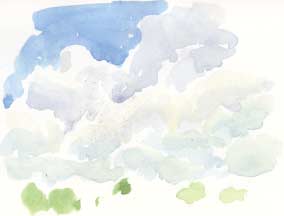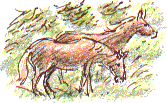
|
May DayGuest Diary by Carollee Ferris, 1st May 2003, New England |
![]() Guest Diaries | Wild
West Yorkshire Home Page
Guest Diaries | Wild
West Yorkshire Home Page
![]()
 Rural
Roads
Rural
Roads
May is my favorite month of the year but today in New England
it's also gloomy with a cold rain predicted for later. I had to go to
New Hampshire yesterday into the foothills of the White
Mountains. I purposefully chose a rural route that wound through the countryside,
like a roller coaster ride. The hills were covered in a veiling of red
(of flowering red maples), dark green (of white pines)and the yellow-green
of tender new leaves (of oak) in wide swaths. Rambling white farmhouses,
gray barns and outbuildings were tucked into the hillsides with red and
gray corrugated metal roofs. Sadly, the days of the small working homestead
is gone, so pastures are few with fewer herefords, milkers, horses or
sheep.
 The
streams are all swollen without being flooded so every hill has a tannin-stained
brook rushing along its valley. Infrequently, a town center would slow
me down. The town centers each had a lovely white wooden town hall (for
the business of the town), one gas station (for petrol) , the best of
New England architecture in its white wooden protestant churches with
soaring bell towers, one general store (for bread, milk or nightcrawlers)
and sometimes a little restaurant (Aunt Bea's Homestyle Cooking which
means fry the meat, macaroni and cheese delight and open a can of peas)
or a craft shop (Karen's Consignment) or an antique store (Latter Daze).
Very quaint, very beautiful and provincial to this area. I was on a mission
with a time limit or I would have stopped to sketch.
The
streams are all swollen without being flooded so every hill has a tannin-stained
brook rushing along its valley. Infrequently, a town center would slow
me down. The town centers each had a lovely white wooden town hall (for
the business of the town), one gas station (for petrol) , the best of
New England architecture in its white wooden protestant churches with
soaring bell towers, one general store (for bread, milk or nightcrawlers)
and sometimes a little restaurant (Aunt Bea's Homestyle Cooking which
means fry the meat, macaroni and cheese delight and open a can of peas)
or a craft shop (Karen's Consignment) or an antique store (Latter Daze).
Very quaint, very beautiful and provincial to this area. I was on a mission
with a time limit or I would have stopped to sketch.
Pickerels and Pinkletinks
Our peepers, (Pseudacris crucifer), a thumbnail-sized
frog with an X on its back, are chorusing in every damp and wet area.
They were also at one time earlier in our history called pinkletinks which
says more about their individual song than their true plangent arpeggio.
The wood frogs, Rana sylvatica, a small pink
frog with a slash of chocolate-brown behind each eye have stopped their
mad duck quacking and gone back into the forest duff for another year.
Their grapefruit-sized egg masses are floating in every vernal pool. For
years, I did studies, tours and talks on the woodfrogs and habitat. I
tried to separate two males in amplex once, to measure the bottom frog.
They squeaked like mice at the pressure I exerted but I would have had
to broken the arms of the top frog to separate them, so strong was his
grip. I'm beginning to hear gray tree frogs, Hyla
versicolor, and their musical trill will last all summer and into
the fall.
An acquaintance of mine finally wrote a definitive text of Maine amphibians
and reptiles, with a CD of frog and toad song. It kind of covers the entire
biogeographic region of which New England is part. I usually have pickerel
frogs (Rana palistris), green frogs,
(R. clamitans), and bullfrogs, (R. catesbeiana),
in my tiny goldfish pond in the back yard. Not all at the same time, the
smaller frogs and my fish made good meals for the green frog and bullfrog
and also garden snakes that find their way into it. We have relatively
few species as compared to warmer climes down south. While I was in Maryland,
I was enchanted by the turtles lumbering across the roads. They were comparative
in number to our scurrying chipmunks. And while I see many flattened chipmunks,
I saw few flattened turtles.
Birds and Bloodsuckers
May is warbler month. It's when the neotropical songbirds return from South America. It's also when our black fly, tick and mosquito hatch occurs. The bloom of those little bloodsucking, itch-inducing nuisances coincide with the return of insect-eating neo-tropicals--how amazing is nature? A very high percentage of the diet of our baby birds is ticks. I kept repeating that to myself when I had to go to a hospital emergency room to have the proboscises of a deer tick taken from my back. First, my husband tried for a half hour, then my daughter tried for 20 minutes and lastly, the doctor tried for 10 minutes and at my urging finally just curetted it out. The probes act like porcupine quills in that the more they are moved, the deeper they work themselves. My usual procedure is to just pull them off and throw them away.
Carollee Ferris,
New England